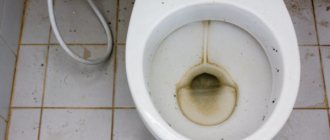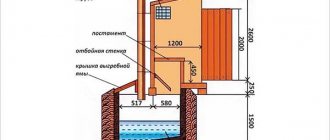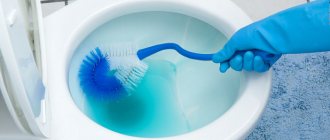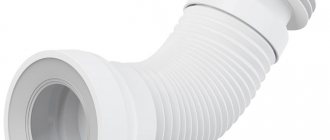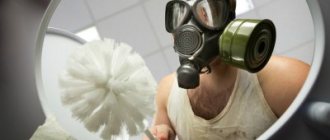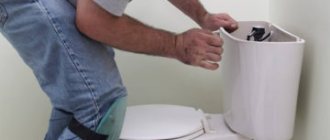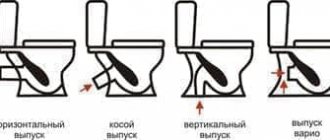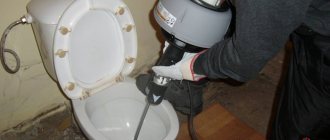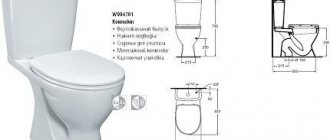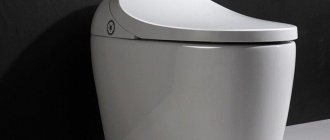The perception of the interior of a particular room largely depends on the details. So, for example, the appearance of clean and snow-white plumbing can transform even the most mediocre interior and give the room a neat look. Conversely, yellowish marks on the surface of a bathtub or toilet will instantly ruin the impression of the most expensive interior. Very often, owners of new apartments have to deal with pollution inherited from previous owners. Sometimes the cause of plaque formation is poor quality water. Be that as it may, before you decide to completely replace the plumbing, you should try to cope with the problem on your own. In this article we will talk about proven ways to clean a toilet from stone and yellow plaque using simple and affordable means.
Why does dirt form in the toilet?
Most often, a yellow coating appears on the surface of the walls of plumbing fixtures, which gradually turns into noticeable lime deposits. They are collected in those places where water flows into the toilet. A predisposing factor to the accumulation of limestone is water saturated with salts. In addition, this process is also influenced by the frequency of use of plumbing fixtures - this means that the less often residents use the drain, the faster deposits accumulate.
Rusty stains
It is not uncommon for noticeable stones to accumulate on the walls of the toilet. Only in this case, the quality of the water does not affect the process, because salts are contained in human urine, which means they enter there every day. This problem often occurs when installing plumbing fixtures with a rough surface. Plaque is characterized by an unpleasant odor, which only intensifies over time, because urinary stones are a favorable environment for the spread of microorganisms.
How to clean a toilet from urinary stone? Read in detail in a special article.
The appearance of the toilet is also spoiled by traces of rust, which also appear in places where water moves from the barrel. There are several reasons for this problem:
- the water contains metals;
- the apartment has an old water supply system with rusted metal pipes;
- a broken drain barrel, causing water to constantly leak;
- presence of manufacturing defects on the walls of the toilet.
It is necessary to constantly maintain the cleanliness of plumbing fixtures
Preventing the formation of contaminants
Once you try to remove traces of old plaque or rust using one of the above methods, you will come to the conclusion that it is better to prevent than to make such efforts.
Especially when you consider that preventive measures are quite simple and require much less time and effort.
- To prevent the formation of limescale, use special tablets for the tank. Their main action is aimed primarily at softening water and neutralizing alkalis. They also tint the water in various shades and give it a pleasant aroma;
- Gel-like products that are attached to the rim of the toilet disinfect the surface with each flush and prevent the formation of urinary stones;
- Make sure that the toilet tank does not leak, otherwise the formation of rust is inevitable;
- If the tank is functioning normally, but rust still forms, it is necessary to replace the old water pipes, otherwise the problem will not go away. If the pipes in the apartment are plastic, it means that corrosion has affected the iron pipes of the central water supply. In this case, only installing a filter will help;
- Once a week, treat the surface of the toilet with chlorine-containing products or regular white. This is both a method of disinfection and elimination of unpleasant odors, and a way to combat the appearance of limescale;
- If the design allows, once a week remove the lid and toilet seat and wash them well with any detergent and then under hot water;
- Make sure that all family members use the drain regularly, otherwise your efforts will be in vain.
Tags:Toilet
- Previous: How to choose and install a dog enclosure in an apartment
- Next: What is: Repair of a one-room apartment
Toilet cleaning methods and preparation
When there is too much dirt on the walls of the toilet, it will take a lot of effort to remove them. For such purposes, various household chemicals, acids, and gentle folk remedies are used. The choice of one method or another depends on the degree of contamination of the plumbing.
Note! You should use various metal meshes to clean the toilet with caution, because they leave mechanical damage on the surface, where dirt subsequently collects.
Rigid metal mesh will only damage the coating
Before you begin the toilet cleaning procedure, you need to prepare:
- The first thing you should do is stock up on rubber gloves to protect your hands, because any alkaline products or acids have a negative effect on the skin.
- Then you will need to scoop out the water from the neck of the toilet. To facilitate this process, you can use a plunger or a large syringe.
Wear gloves when working with any toilet cleaning products.
Rules for working with household chemicals
In pursuit of a clean toilet, it is important not to rush and avoid mistakes.
To do this you need to follow a few simple rules.
- To avoid causing damage to the enamel and the accumulation of new plaque, never overexpose gels and acid-based liquids.
- After cleaning, rinse off any aggressive cleaning agent with water only with the lid closed so that splashes do not get on the skin.
- To avoid chemical skin burns, vapor poisoning or an allergic reaction, try to work with household chemicals wearing protective gloves and a mask, and do not lean too much over the surface being treated.
- Never use Electrolyte or any other sulfuric acid-based liquid if metal-plastic pipes lead to the toilet.
When the cleaning is done and the toilet is sparkling clean, the question arises: how to prolong this condition and prevent the formation of new contaminants?
When choosing household chemicals to remove limescale, focus on the composition, the main active ingredient, the scale of the problem and the condition of the toilet itself. Also, when choosing, you should take into account the cost and toxicity of the gel or liquid.
Folk remedies for rust removal
If the pollution is not too noticeable, then you can deal with it using folk remedies, which every housewife can find. Their main advantage is that such components do not destroy the integrity of plastic water pipes. In addition, you can purchase components for cleaning the toilet according to “folk recipes” on a very budget and in any store near your home.
Citric acid: step-by-step instructions
You will need to prepare 2-3 packets of citric acid, as well as cleaning equipment: brushes, brush.
Step one: first you need to scoop out all the water from the toilet and pour citric acid into it.
The acid should cover all contaminants inside the plumbing fixtures and under the rim in a dense layer
Step two: now you need to close the toilet lid and leave it for 3.5 hours. If there are a lot of deposits and traces of rust, the holding time will have to be increased.
Upon completion of the procedure, it is necessary to rinse off the acid, and then remove any remaining dirt with a brush.
Citric acid with vinegar: step-by-step instructions
You will need to use two packets of citric acid, a third of a glass of vinegar and various tools for cleaning the toilet.
Step one: you need to pour citric acid into a dry toilet bowl as in the previous method. Then apply vinegar on top of the dirt from a spray bottle, which will react with the acid (the powder will hiss and foam).
This mixture must be left on the surface of the toilet for about four hours.
Step two: when the plaque softens, it can be easily removed with a brush
Clean the structure with a brush
Vinegar and iodine: step-by-step instructions
Step one: first of all, you need to pour vinegar into a container and burn it to about 45 degrees, you also need to add a few drops of iodine. Then the mixture must be poured into a dry toilet.
The shade of the liquid should not be dark
Step two: Next, you should take any rag (afterwards you will have to throw it away), moisten it in the bite solution and apply it to particularly contaminated areas. The toilet should be left in this form for 4.5 hours.
After a while, you will need to remove the rags and rinse the toilet with water to remove plaque.
Soda and vinegar: step-by-step instructions
There are two effective options for cleaning the toilet using baking soda and vinegar. In order to choose the right one, you need to consider them in more detail.
Option #1
You will need to prepare one glass of vinegar, a couple of tablespoons of baking soda and any container that is suitable for heating on the stove. In addition, you will need brushes, sponges, and a brush.
Step one: you need to put a container of vinegar on the stove and then boil it. Add baking soda to hot vinegar
Regular table vinegar is suitable for preparing the mixture.
Step two: before this mixture has cooled, you need to pour the dirt into it.
After a few hours, you need to rinse the toilet with clean water.
Option No. 2
During the cleaning process you will need vinegar, baking soda, a spray bottle, gloves and sponges.
Step one: First, you need to mix baking soda with water to form a thick paste.
Apply this composition to traces of dirt and rust and leave for 50-60 minutes.
Step two: now you should pour the vinegar into a spray bottle and apply it to the soda.
When this mixture stops fizzing, you will need to flush the toilet.
Step Three: The plumbing will need to be washed again with soapy water.
You can use any liquid soap
Baking and soda ash
It is necessary to prepare baking soda and soda ash in equal quantities, as well as gloves and brushes.
You will need to pour two types of soda into the toilet and leave for about 9-10 hours (it is recommended to do this at night). In the morning, all that remains is to rinse the plumbing with water. It is recommended to repeat this procedure several times.
Baking and soda ash
Other folk methods of combating pollution
There are other ways to deal with rust using improvised means:
- Sparkling water. On the Internet you can find many recipes for cleaning plumbing fixtures with the Coca-Cola drink. Indeed, soda can dissolve any deposits in 7-8 hours. To enhance the effect, you will need to pour vinegar or a packet of citric acid into the toilet. On average, about 3 liters of drink are required.
- Toothpaste. This product can be used for both internal and external cleaning of the toilet. It is recommended to use an old toothbrush (in hard-to-reach places) and a brush as a cleaning device. However, this method is only effective if there are minimal deposits.
- Dentifrice. This is another effective and affordable remedy for the population. It is necessary to pour a package of tooth powder into the toilet, and then thoroughly clean it with a brush, then rinse with water. The advantage of the product is that after the procedure a pleasant mint aroma remains.
Any carbonated drink can be used to clean the toilet.
Dentifrice
Traditional methods of struggle at home
To cope with urinary stones and limescale on the toilet yourself, you can try using proven folk methods. They will cope with minor as well as old deposits and deposits, especially if we are talking about a local sewer system or a plastic pipeline.
Soda and vinegar
Baking soda has a bleaching effect, so this substance can be used to clean plumbing fixtures. And if you add vinegar to it, the result will be even more positive. To do this, you need to prepare a special solution, when you take a large spoon of soda powder per tablespoon of acetic acid. The cleansing scheme will look like this:
- First, the sewer system is cleaned and excess water is pumped out.
- Places with plaque are wiped dry.
- Wipes are moistened in the resulting solution and applied to the treated areas.
- After six hours, the remaining plaque is removed with a scraper, and the treated areas are washed with water.
See also
How to properly and quickly clean the house, where to start and what stages to divide into
Lemon acid
To remove lime and stone formed on the walls of the toilet, you can try using citric acid. Several sachets of this product should be diluted with a little water to form a kind of liquid powder.
Contaminated areas are treated with the finished composition. The citric acid is left to work for at least three hours. To obtain a more pronounced result, the duration of exposure should be at least twelve hours.
Acetic acid
Acetic acid, without damaging the surface of the toilet bowl, corrodes all existing deposits. You should generously moisten paper napkins in vinegar and apply them to places where there are contaminants. After three hours, the toilet is flushed with water.
Oxalic acid
Oxalic acid also effectively cleans the walls of the toilet bowl. It is better to purchase this product in crystallized form. They need to treat the rim of the plumbing fixtures and areas where there is plaque. The composition is left to act for six hours. The toilet is flushed with water using a brush.
Baking soda
If we are talking about small stains, then ordinary soda will cope with them. It needs to be poured onto places where there is contamination. It is better to leave the product on overnight. After sleep, the soda is washed off with warm water.
Coca Cola
The carbonated drink Coca-Cola will help you get rid of lime and urinary stones on your own. The composition of soda is able to quickly corrode formed contaminants, even if they are old in nature.
To do this, you need to pour Coca-Cola into the toilet, and after two hours, clean the plumbing with a brush. The amount of drink used must be at least two liters.
Alkaline products
Alkaline-based products are available in gel form; they have a high pH level, which allows them to quickly remove stains.
The most popular manufacturers of alkaline cleaning products:
- Bios;
- Sif;
- Baxix;
- Domestos;
- DeLaval.
Alkaline products
All these products have similar instructions for use:
- Remove water from the toilet.
- Apply the product generously along the inner walls and on the rim.
- Bid my time. The duration of action of such products ranges from 5 to 30 minutes.
- Then you will need to wash off the remaining product along with the dirt.
Note! It is not always possible to cope with rust from the first application, so such actions will have to be repeated several times.
How to bleach the inside of a toilet
When cleaning the toilet, most housewives are faced with the problem that dirt does not drain well under water. This is due to the fact that water dissolves household chemicals, and the concentration of active substances becomes less.
To clean the toilet in hard-to-reach places, the liquid must initially be removed from the bowl .
To do this, water is drained from the tank and its flow is blocked, after which the remaining liquid is pushed through with a plunger or scooped out with available containers. Then, pour in cleaning agents and leave to act for the required time. The field of this is cleaned as usual.
Acids and acid-containing products
If after all the above manipulations the rust and urinary stones remain in place, then it is recommended to try strong acid-based products. It should be remembered that they are unsafe - if aggressive cleaning agents are used incorrectly, you can not only ruin your plumbing, but also cause harm to your health.
As additional protection, in addition to gloves, you will need a respirator and special glasses. Otherwise, you can get a burn to the respiratory tract or mucous membrane of the eyes.
Table 1. Acids against rust and dirt
| View, illustration | Description |
| Phosphoric acid (6%) | This acid quickly dissolves traces of limescale, rust and urinary stones. At the same time, it does not damage plastic pipes. For the cleaning procedure you will need no more than 130 grams of product, which should be left there for no more than 20 minutes. After which you will need to thoroughly wash the plumbing with water and soap. |
| Oxalic acid | This is a very caustic product that emits vapors that are hazardous to human health. It can be found on sale in the form of a light powder. It is necessary to apply oxalic acid pointwise to traces of rust (if desired, you can immediately dilute it with water). After that, the toilet must be left for 60 minutes, and then rinsed with water several times. |
| Hydrochloric acid (35%) | This is also a caustic agent that, in addition to contaminants, corrodes rubber and plastic. Therefore, you should not use hydrochloric acid in the presence of plastic pipes. In this case, you should not dry the toilet before cleaning it. You need to sleep no more than 130 grams of acid at a time. Its exposure time is about 20 minutes, after which the toilet should be rinsed several times with water. It is advisable to work with hydrochloric acid in a room where there is a good ventilation system. |
| Battery electrolyte | The main component of the electrolyte is sulfuric acid, which belongs to the category of dangerous toxic chemicals, so such a product should be used carefully. It is also not suitable for plastic sewer pipes. As with the previous method, you will need to pour about 130 grams of electrolyte into the toilet. This must be done carefully so as not to affect the plastic elements of the plumbing. Upon completion of the procedure, you should rinse the toilet with clean water and soap. |
Household products based on acids:
- "Silit Bang". A liquid product that, when sprayed, turns into a thick foam. Its action time does not exceed five minutes, it effectively copes with rusty stains.
- "Sanfor". This product allows you to clean the surface of plumbing fixtures from rust and eliminates pathogenic microorganisms.
The advantages of these liquid cleaning products are that they do not scratch the finish of plumbing fixtures and are economical to use.
Little tricks
If there is no cleaning product, you can clean the surface of the toilet bowl from rust stains as follows:
- Apply toothpaste to the desired area and brush with a brush.
- Moisten a rag with a drink such as Cola, Sprite or Fanta and place it on the contaminated area. After some time, you need to rinse the area with water.
- Cover the stain with battery electrolyte. After 15 minutes, wash off the liquid.
In order for the plumbing fixtures to maintain their original appearance for as long as possible, it is necessary to regularly clean them and eliminate possible breakdowns in a timely manner. At the stage of purchasing plumbing fixtures, it is appropriate to choose items with a water-repellent glaze, which prevents the occurrence of contamination.
Abrasive agents against rust and plaque
Such products have the same properties as acids. They have a budget price and quickly cope with even stubborn stains. However, you should not use them too often or intensively, otherwise you may damage the toilet's coating.
Table 2. Popular toilet bowl cleaners with abrasive particles
| View, illustration | Description |
| Pemolux | This product copes even with old stains and a dense layer of plaque. Its main advantage is the absence of aggressive alkaline components. After using the product, there are no smudges left on the surface, and no pungent odor is released. |
| Sarma | A popular cleaning product that removes rust and cleans plumbing fixtures to a shine. Moreover, this cleaning powder effectively eliminates any bacteria. In particularly contaminated areas it should be kept for at least 25 minutes. |
| Sanita "Anti-rust" | This is a fast-acting product that turns into foam when used. Any dirt, including yellow stains, disappears in ten minutes. |
Prices for popular cleaning products for plumbing and pipes
Plumbing and pipe cleaners
Causes of deposits
In order to choose an effective way to combat deposits on sanitary ceramics (faience), you must first find out the reasons for their appearance, composition, etc. The proverb “You need to know the enemy by sight” is also appropriate in our difficult task.
Plaque not only spoils the appearance, but also destroys the enamel of the plumbing fixture
Limescale is a deposit of minerals, which are found in excess in tap water, on the surface of ceramic and chrome-plated products. Mostly, pollution forms in flush areas in the form of yellow-orange smudges. Moreover, the more often the water is flushed in the toilet, the faster plaque forms.
Important! If deposits are not removed from the water supply nozzles in a timely manner, deposits can cause them to become clogged. Monitor the condition of each of your “home helpers”.
Urine stone is a deposit of mineral substances found in the human body. They are excreted along with urine and settle on the walls of the ceramic product. Combining with the minerals contained in the water, they form a dense and very unaesthetic layer of gray-yellow color. Irregularities in the ceramic coating aggravate and accelerate this process.
If the ceramics are initially of poor quality, then plaque will form on it faster due to the porosity of the material
When choosing sanitary ware, check the smoothness of the inner surface of the bowl. The ideal option is to purchase a product made from sanitary porcelain; unlike cheaper earthenware, it has a dense structure. This is achieved due to the increased temperature at which the product is fired. And it is the density that makes porcelain toilets smoother, and plaque and stone do not eat into the porcelain structure so quickly, so it is much easier to clean it by hand.
It should be understood that sanitary porcelain is a material for the manufacture of luxury sanitary ware, and therefore its price is much higher than that of models made of earthenware. Whether to classify this feature as a disadvantage is up to each user to decide for themselves.
Porcelain product
The main reason for the appearance of deposits of any kind is the neglect of preventive methods for cleaning ceramics. It should be remembered that the more often the planned cleaning of the toilet room and cleaning of plumbing fixtures is carried out, the longer the toilet remains in its original form.
Using bleach against rust
The well-known “Whiteness” or any other chlorine-based product quickly copes with urinary stones, plaque and rust. For best results, it is recommended to fill the toilet with bleach for 10-12 hours (at night), and then rinse thoroughly with a brush and clean water.
If desired, you can pre-rinse the plumbing with an alkaline solution, and only then use chlorine. Just remember that alkali and “Whiteness” react, so your face will also have to be protected with a respirator from harmful fumes.
“Whiteness” is a rust remover that has been proven over the years
How to clean a toilet from difficult stains
We have listed the main points to pay attention to and the procedure to follow when cleaning the toilet. But what to do if for some reason the toilet is already heavily covered with limescale, urinary stone and rust? Is it possible to somehow eliminate them, or is the only solution to buy a new toilet?
In most cases, it is still possible to eliminate unsightly plaque. And even if the toilet doesn’t become “as good as new,” it will still be noticeably cleaner.
Strong acids and alkalis deal best with deposits. Thus, for the fight, you can choose a particularly strong remedy, which says that it is intended for severe pollution - for example, “Shumanit”.
You can also use household products. Citric acid, ordinary vinegar or soda are especially popular.
According to the principle of operation, they work approximately the same way - the product is poured or poured into the toilet bowl and left there for several hours (therefore, it is advisable to fill the toilet bowl at night and close the lid). The difference is mainly in the dosage:
- if you use soda, then you need to pour the whole pack into the toilet;
- in the case of a bite, a glass will be enough - but it is advisable to slightly warm the liquid before this and add soda or iodine (a spoon) to it;
- citric acid is poured in the amount of 4 - 5 sachets.
Whiteness, which is generally very widely used on the farm, also helps to cope well with plaque.
To remove light and medium stains, simply rinse thoroughly with water and wipe with a sponge before doing so. Heavy deposits will have to be dealt with with a brush.
Cleaning company services
Long-term stains and old rust marks are difficult to deal with at home, so many housewives prefer to use the services of specialists. They have special equipment and a full arsenal of all devices and chemicals. The only downside is that such a service has a high cost.
However, turning to cleaning specialists for help has clear advantages. Firstly, you won’t have to waste time doing less than pleasant work. Secondly, people with respiratory problems, asthmatics and allergy sufferers, in principle, should not have contact with caustic household chemicals, and it would be more logical for each person to refuse to try to wash the plumbing on their own if they are protecting their health.
The company’s specialists will cope with pollution of any complexity
Store-bought chemicals
Household chemicals intended for cleaning sanitaryware come in several types. Their main difference is the release form:
- Gel. Most often used. They usually come in bottles with an easy-to-use neck. Its shape allows you to apply the gel even under the headband. In addition, thanks to this it is possible to protect the skin from aggressive substances. The gels are applied very evenly.
- Liquid. It works in the same way as the gel, but is used less economically.
- Powder. In most cases, they are considered universal, that is, suitable for cleaning many surfaces. Their use requires the use of physical force. The abrasive components that make up the powders are quite effective at removing limescale and urinary stones. But they also have one drawback - the risk of damaging the surface.
Generally speaking, all household chemicals must meet several requirements.
- Effectively remove limescale from the surface of the toilet bowl. This is done best by those substances that contain acid. They should be used with the utmost caution. It is necessary to avoid getting the acid on the skin and its vapors into the respiratory tract.
- Remove old dirt.
- Get rid of unpleasant odors, and even better - leave a pleasant fresh aroma.
- Have an antimicrobial effect.
Illustrative examples
Let's look at some of the most effective toilet cleaners:
- Pemolux or Sarma cleaning powders. Apply to a sponge, which then needs to be thoroughly wiped over the contaminated areas.
- "Domestos". This is a thick gel that helps in the fight against complex stains. It contains hydrochloric acid. The substance acts a little slower than others. However, when using it, no effort is required to remove plaque. In addition to plaque, Domestos removes bacteria and fungus.
- Gel "Cillit Bang". Like other products, it contains hydrochloric acid. In addition to removing plaque, it perfectly whitens the surface of the toilet bowl and gives it shine. Manufacturers recommend using rubber gloves when working with the gel. One of the disadvantages of “Cillit Bang” is its rather high price.
- Comet. According to the instructions, the effect of using the gel lasts much longer than other similar products. The main active ingredient is sulfuric acid. It is this that ensures the high efficiency of Comet. The disadvantages include a pungent odor that is not overcome even by fragrance.
- Active gel “Toilet duckling”. It does not have such a thick consistency, which, however, does not affect the effectiveness. It has a pleasant smell.
- "Sanox Ultra". This substance belongs to the budget group. Quickly removes both fresh and stubborn stains. Fights all types of pollution. The only drawback is wasteful consumption.
- Gel "Sanfor". It contains chlorine, which has an antimicrobial and disinfectant effect. Actively fights mold, fungi and plaque of various origins. It is distinguished by its affordable price and versatility. The product is suitable for cleaning any surfaces.
Since almost all of the above substances contain surfactants (surfactants that make cleaning easier), alkalis or acids and chlorine, it is necessary to use protective gloves when working with them.
So, cleaning a toilet from rust and plaque is not so difficult. To do this, you can use a variety of means, from improvised ones to store-bought chemicals. Cleaning gels for the most part remove almost all contaminants, have a low price and a wide spectrum of action.
Mistakes in caring for plumbing fixtures
To clean the toilet, it is not recommended to use soft sponges that are intended for washing dishes, because such a structure is an excellent environment for the accumulation of pathogens. Therefore, if you still had to use such a sponge, then after completing the procedure it should be disposed of.
Special long-handled devices are sold for plumbing maintenance.
If a dense layer of urinary stones and noticeable rust stains do not accumulate on the surface of the toilet, then it is not recommended to overuse cleaning products based on strong alkali or acids, because such components gradually destroy the coating.
Features of cleaning the tank
Video - Cleaning the toilet tank
Preventing rust in the toilet
With good care of your plumbing, the appearance of rust can, in principle, be prevented, and then you won’t have to waste effort cleaning the toilet from yellow plaque:
- It is necessary to take the time to clean your plumbing regularly, at least once a week, using alkaline or chlorine-containing products.
- It is necessary to monitor the serviceability of the toilet and carry out minor repairs on time. If water leaks even a little from the tank, yellow stripes on the walls of the plumbing will appear much faster, and it will not be possible to completely remove the rust from the toilet even with the help of strong means.
- The condition of the toilet is influenced by the quality of tap water. If the water is too hard and mixed with rust from the pipes, then a yellow coating on the walls of the plumbing will appear faster. In addition, low-quality water often leads to breakdowns of the drainage system. You can solve the problem if you put special tablets in the toilet tank that help clean and soften the water.
- Rust forms faster in the toilet if the water pipes have not been replaced for too long and are rusty. It is recommended to replace old pipes; this will not only make it easier to care for your plumbing and help you clean it faster, but will also help you avoid accidents.
When using the toilet every day, it is necessary to keep it clean with a brush. You should not pour leftover food and fatty broths down the drain; all this leads to the formation of a thin greasy film on the walls of the plumbing. In this case, rust occurs faster. If the toilet is still used to dispose of food waste, then immediately after draining the remaining food, it must be cleaned with a brush.
Preventive actions
Of course, there are a large number of means to combat traces of rust, but in practice it is recommended to avoid such problems so as not to face the need for serious cleaning. Here are the rules to follow to ensure that the toilet always looks presentable:
- Clean the toilet every day with an organic product that does not contain alkali.
- Disinfect plumbing fixtures weekly with bleach.
- Use strong chemicals to clean contaminants at least once every 30 days.
- Check the pipes periodically - if they are rusty on the outside and inside, you will need to replace them with plastic ones.
- Treat bacteria under the toilet rim.
- Quite often, lime deposits appear in the presence of contaminated tap water. Installing special filters in the system, which will have to be changed from time to time, will help correct this problem.
It is necessary to periodically clean the toilet from plaque and rusty stains.
When choosing a toilet, it is recommended to choose products made of porcelain - this material has a smooth structure, which means it does not retain dirt and stones.
Prices for toilets, urinals, bidets
Toilets, urinals, bidets
How to clean a cistern
When choosing a means to clean a toilet tank from rust, you should consider the following points:
- It’s better not to settle on choosing abrasive compounds that can leave scratches. Subsequently, the damage will become clogged with dirt, and the service life and operation of the plumbing fixtures will be reduced;
- A product to clean a porcelain toilet from rust must be intended for a device made of a specific material. All the data that needs to be taken into account is usually indicated on the packaging;
- Adjacent pipes should be washed. For parts consisting of different materials, it is worth using components that comply with the instructions.
To disinfect the toilet cistern and remove rust from it, a special tablet should be placed in the cavity. For preventive purposes, it is recommended to install a special cleaning filter.
Is it possible to prevent the formation of yellowness, how to remove plaque
There is only one way to protect yourself from such water: install a high-quality filter directly at the entrance to the apartment. The filter will filter out iron particles and block lime deposits. Deep purification filters make water pure, suitable for any use, including food purposes.
In new houses, especially luxury buildings, such filters are installed in every apartment. The cost of such a filter is not so high that an ordinary person cannot buy it. In any case, this will allow you to maintain your health and your plumbing in its original form.
But if you still can’t buy a filter, you can buy special tablets for the tank. These tablets are based on substances that completely break down particles of iron and lime deposits. Additionally, the tablets flavor the water, and some also disinfect.
The only caveat is that they are not always effective against rust. But there is only one preventative weapon against it: replacing parts in the tank or adjusting the float. There will be no rust if there is no stream flowing from the tank down the center of the toilet.
However, all these methods help remove the formation of plaque and rust. But they provide little protection from something else: living bacteria and microorganisms that are always present where there is water.
Most of them are harmless to humans and animals, since they are already present in our bodies. But some of them can cause serious illness.
